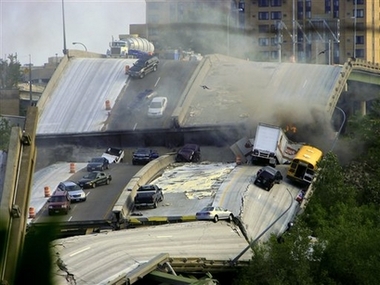7 killed in Minneapolis bridge collapse
(AP)Updated: 2007-08-02 13:34
MINNEAPOLIS - An interstate bridge jammed with rush-hour traffic suddenly broke into huge sections and collapsed into the Mississippi River Wednesday, pitching dozens of cars 60 feet into the water and killing at least seven people.
"There were two lanes of traffic, bumper to bumper, at the point of the collapse. Those cars did go into the river," said Minneapolis Police Lt. Amelia Huffman. "At this point there is nothing to suggest that this was anything other than a structural collapse."
Jamie Winegar of Houston was sitting in traffic shortly after 6 p.m. when all of a sudden she started hearing "boom, boom, boom and we were just dropping, dropping, dropping, dropping."
The car she was riding in landed on top of a smaller car but did not fall into the water. She said her nephew yelled, "'It's an earthquake!' and then we realized the bridge was collapsing."
Minneapolis Fire Chief Jim Clack said 60 people were taken to area hospitals for treatment and that the death toll could rise.
Rescuers called off the search as nightfall made it too dangerous to search the waters, which were filled with chucks of the mangled bridge and at least 50 vehicles in the water.
"We think there are several more vehicles in the river we can't see yet," Clack said, adding that the likelihood of finding survivors was slim.
Authorities referred family members searching for missing loved ones to a nearby hotel, where the Red Cross had set up operations.
Dr. Joseph Clinton, emergency medical chief at Hennepin County Medical Center, said his hospital treated 28 injured people ¡ª including six who were in critical condition.
Clinton said at least one of the victims had drowned.
The Homeland Security Department also said the collapse did not appear to be terrorism-related. The National Transportation Safety Board planned to send a team of investigators to Minneapolis, NTSB spokesman Ted Lopatkiewicz said.
Gov. Tim Pawlenty said the bridge was inspected by the Minnesota Department of Transportation in 2005 and 2006 and that no structural problems were noted. "There were some minor things that needed attention," he said.
Police Chief Tim Dolan said officers were checking other bridges as a precaution.
The steel-arched bridge, which was built in 1967, rose about 64 feet above the river and stretched about 1,900 feet across the river. The bridge was built with a single 458-foot-long steel arch to avoid putting any piers in the water that might interfere with river navigation.
A burning truck and a school bus clung to one slanted slab. The bus had just crossed the bridge before it crumpled into pieces.
Christine Swift's 10-year-old daughter, Kaleigh, was on the bus returning from a field trip and called her mother. "She was screaming, 'The bridge collapsed!'" Swift said.
She said a police officer told her all the kids got off the bus safely.
It appeared that the center section of the bridge dropped straight down and pancaked in the middle of the river, leaving several vehicles stranded on a broken island of wreckage. As divers plumbed the waters, other rescuers searched frantically for victims amid broken, zigzagged sections of blacktop. Some of the injured were carried up the riverbanks.
Dozens of vehicles were scattered and stacked on top of each other amid the rubble. Some people were stranded on parts of the bridge that weren't completely in the water.
Many motorists may have been headed to the Minnesota Twins game not far from the bridge. Team officials decided to play the game after conferring with department of public safety officials. It was decided that sending 20,000 to 25,000 people back into traffic could hinder rescue efforts, said team president Dave St. Peter.
Catherine Yankelevich survived a 1994 earthquake in Northridge, Calif., and was on the I-35W bridge when it began to shake. "Cars started flying and I was falling and saw the water," she said. After her car plunged into the river, she climbed out the driver's side window and swam to shore uninjured.
Road crews had been working on the 40-year-old bridge's deck, joints, guardrails and lights this week. "None of it would be related to the structure," said Bob McFarlin, assistant to Minnesota Transportation Commissioner Carol Molnau.
The bridge was scheduled for inspection this fall, he said.
Tom Sloan, head of the bridge division for Progressive Contractors Inc. said his company had 18 workers on the bridge at the time of the collapse and one was unaccounted for on Wednesday night. Three were hospitalized, while several others were treated for minor injuries, he said.
"Obviously, this is a catastrophe of historic proportions for Minnesota," said Pawlenty said. "And right now we are focused on making sure that we are doing everything to respond to the needs of those individuals that may have been harmed in this incident."
|
|
|
||
|
||
|
|

